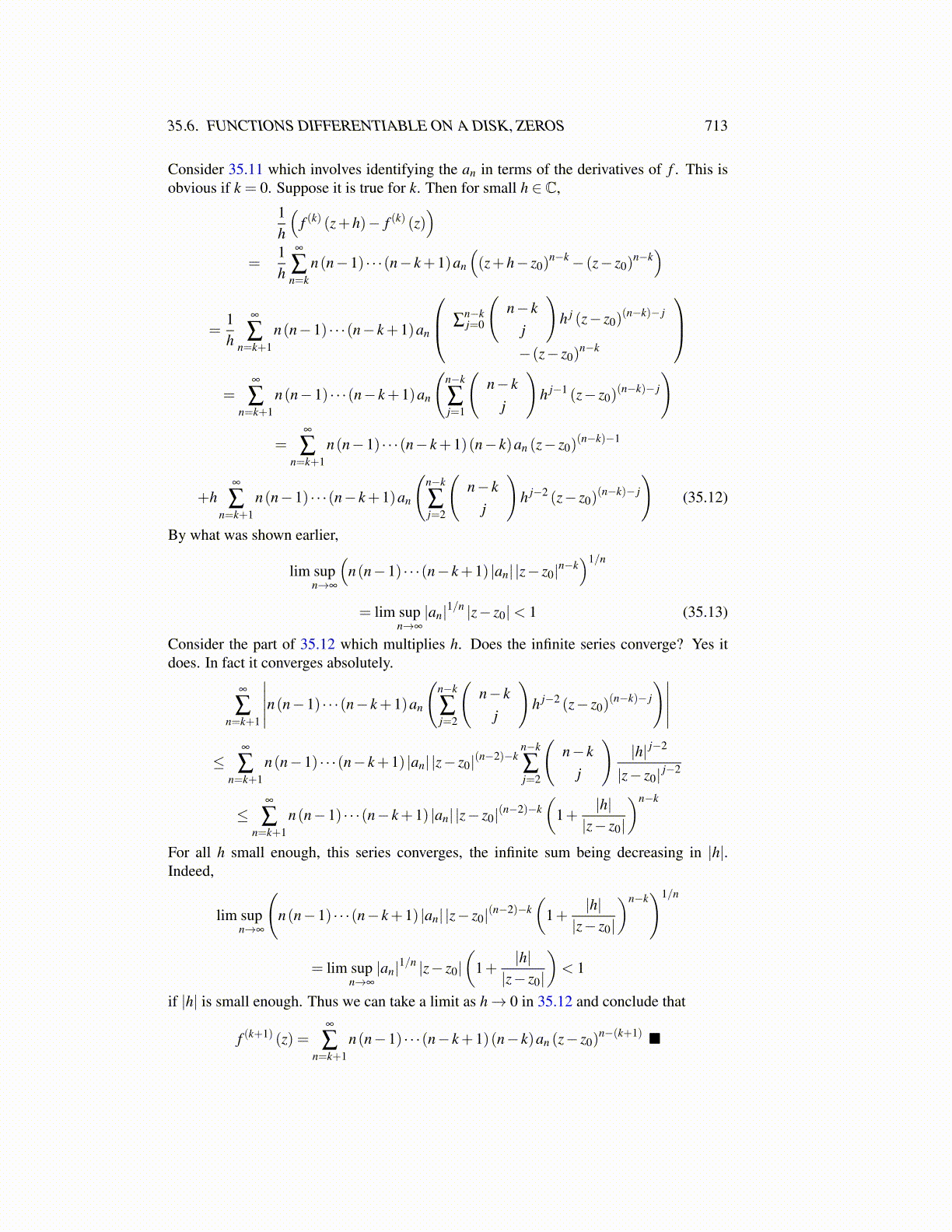
35.6. FUNCTIONS DIFFERENTIABLE ON A DISK, ZEROS 713
Consider 35.11 which involves identifying the an in terms of the derivatives of f . This isobvious if k = 0. Suppose it is true for k. Then for small h ∈ C,
1h
(f (k) (z+h)− f (k) (z)
)=
1h
∞
∑n=k
n(n−1) · · ·(n− k+1)an
((z+h− z0)
n−k− (z− z0)n−k)
=1h
∞
∑n=k+1
n(n−1) · · ·(n− k+1)an
∑n−kj=0
(n− k
j
)h j (z− z0)
(n−k)− j
−(z− z0)n−k
=
∞
∑n=k+1
n(n−1) · · ·(n− k+1)an
(n−k
∑j=1
(n− k
j
)h j−1 (z− z0)
(n−k)− j
)
=∞
∑n=k+1
n(n−1) · · ·(n− k+1)(n− k)an (z− z0)(n−k)−1
+h∞
∑n=k+1
n(n−1) · · ·(n− k+1)an
(n−k
∑j=2
(n− k
j
)h j−2 (z− z0)
(n−k)− j
)(35.12)
By what was shown earlier,
lim supn→∞
(n(n−1) · · ·(n− k+1) |an| |z− z0|n−k
)1/n
= lim supn→∞
|an|1/n |z− z0|< 1 (35.13)
Consider the part of 35.12 which multiplies h. Does the infinite series converge? Yes itdoes. In fact it converges absolutely.
∞
∑n=k+1
∣∣∣∣∣n(n−1) · · ·(n− k+1)an
(n−k
∑j=2
(n− k
j
)h j−2 (z− z0)
(n−k)− j
)∣∣∣∣∣≤
∞
∑n=k+1
n(n−1) · · ·(n− k+1) |an| |z− z0|(n−2)−kn−k
∑j=2
(n− k
j
)|h| j−2
|z− z0| j−2
≤∞
∑n=k+1
n(n−1) · · ·(n− k+1) |an| |z− z0|(n−2)−k(
1+|h||z− z0|
)n−k
For all h small enough, this series converges, the infinite sum being decreasing in |h|.Indeed,
lim supn→∞
(n(n−1) · · ·(n− k+1) |an| |z− z0|(n−2)−k
(1+
|h||z− z0|
)n−k)1/n
= lim supn→∞
|an|1/n |z− z0|(
1+|h||z− z0|
)< 1
if |h| is small enough. Thus we can take a limit as h→ 0 in 35.12 and conclude that
f (k+1) (z) =∞
∑n=k+1
n(n−1) · · ·(n− k+1)(n− k)an (z− z0)n−(k+1) ■